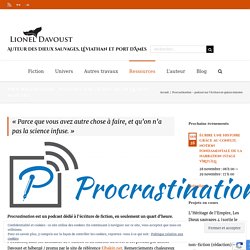

Mrs Roots – Ecrire. Pour qu'il ne soit plus possible de dire encore une fois : Je ne savais pas. Procrastination – podcast sur l’écriture en quinze minutes. Procrastination – podcast sur l’écriture en quinze minutesLD2020-10-12T18:48:32+02:00 « Parce que vous avez autre chose à faire, et qu’on n’a pas la science infuse. » Procrastination est un podcast dédié à l’écriture de fiction, en seulement un quart d’heure.

Le 1er et le 15 de chaque mois, Lionel Davoust, Estelle Faye et Mélanie Fazi discutent de l’art et de la technique de la narration, partagent leur expérience, et s’aventurent aussi, à l’occasion, dans les domaines de l’édition et du marché du livre. Il est produit par Lionel Davoust et hébergé / promu par le site de référence Elbakin.net.
Remerciements chaleureux à Laurent Genefort pour sa participation aux trois premières saisons du podcast ! Procrastination est disponible sur les plate-formes suivantes : Et même, tout simplement, en écoute libre et directe ci-dessous ! Elbakin Net. Occupational Hazard, a naruto fanfic. Rated M for smut This work is unedited (6/22/20) The loud click-clacking of her red pumps on the white terrazzo floor captures the office's attention, signaling her arrival, and by the speed of her walk, her mood.

Sakura Haruno is pissed. Dressed impeccably in her red dress blouse and black pencil skirt, she very much looks like the senior editor she is. Working for the renowned women's magazine, Kunoichi, is no easy task. Now at twenty-eight, Sakura has made a name for herself as the senior editor of the health and fitness section of Kunoichi Magazine. And she did, quicker than even she expected. Countless eyes follow her as she makes her way to her office, curiosity evident in their gazes. As they see her close her office door, groups of them begin huddling around each other. "Why do you think she's mad? " "Is that even a question? "Ah! " "What do you think he said this time? " "I don't know, but I mean, why are we even surprised at this point? "I wonder why…" "What's with that smile? " Sasuke. Scriptnotes. Mecanismes d'histoires. Prom'Auteur - De l'écrivain au lecteur.
Julien Hirt – Auteur. Dominic Bellavance, écrivain Get Started - Save the Cat!® Save the Cat!

Provides writers the resources they need to develop their screenplays and novels based on a series of best-selling books, primarily written by Blake Snyder (1957- 2009). Blake’s method is based on 10 distinctive genres and his 15 story beats (the Blake Snyder Beat Sheet). Our books, workshops, story structure software, apps, and story coaching teach you everything you need to unlock the fundamentals and mechanics of plot and character transformation. Our website offers beat sheets, tips and tactics, informative blogs, and guidance for writers — along with sharing the successes of both our teachers and students. Welcome to the introduction to Save the Cat! As storytellers, we need to meet only one demand: Tell us a story about transformation. Every story is “The Caterpillar and the Butterfly.” But when it seems like this purgatory will never end, when things look the most bleak, there’s another stirring. Where do you start?
Online Writing Classes and Workshops. How to create an awesome plot outline! A step by step guide. After you’ve figured out the rough plot of your novel (I used the first 4 steps of Randy Ingermanson’s snowflake method), it may help you to outline it.

An outline can be viewed as a basic ‘wire-frame’ of your plot which you can refer to throughout the first draft stage. Although it isn’t for everyone (some may find it too prescriptive), it can be helpful in ensuring that you don’t forget any of the major plot points or stages of character development. Your outline can also help you to figure out when to incorporate subplots and to identify elements of your novel which don’t fit in with the overall storyline. This method assumes that you have plotted your novel using the three act structure, and that you have a rough idea of your storyline. You can read more about planning your novel and using the three act structure here.
This method gets you to think carefully about the beginning, middle and end of: Your novel as a wholeEach of your three actsThe chapters and scenes within the acts.